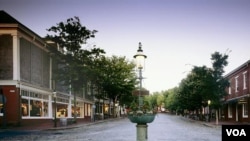Forty-three kilometers off the coast of the northeastern state of Massachusetts lies the island of Nantucket.
It’s the size of New York City’s Manhattan Island, but with about a million and a half fewer residents. Just 10,000 or so year-round - but at least five times that number each summer.
There’s no bridge or tunnel to the island, so you have fly or take a ferry to get there. Its isolation, and the treacherous shoals that surround it, kept Massachusetts’ early settlers away and the landscape wild.
Nantucket was once the biggest and busiest whaling port in the nation - the place from which the fictional Captain Ahab set off in search of the great white whale Moby Dick in Herman Melville’s novel.
These days, Nantucket is still relatively unspoiled. It’s a peaceful place with none of the high-rise hotels, honky-tonk boardwalks, amusement parks, or shopping centers of other beachfront resorts.
There is just one town, with cobblestone streets, cottages with flower boxes and gardens and white picket fences, and expensive restaurants and guest houses with porches full of wicker furniture - perfect for reading or dozing.
Nantucket also has 90 kilometers of pristine beaches and a picturesque harbor with some of the fanciest yachts you’ll see. The island is often so fog-bound that it got the nickname, “The Gray Lady.”
And 45 percent of the island is preserved for all time as free and open space and nature preserves.
This unusual preservationist victory traces to the work of one man - Walter Beinecke, Jr., the heir to a trading-stamp fortune.
In the 1950s, Nantucket Harbor was decayed and declining. Beinecke bought 55 percent of the commercial space and began building reproductions of 18th-century architecture.
And he purchased whole swaths of open land and set them aside as protected space.
Beinecke’s efforts completely changed the character of Nantucket, from a dingy outpost that many people avoided to a highly desirable summer destination - for those who can afford it.
It’s the size of New York City’s Manhattan Island, but with about a million and a half fewer residents. Just 10,000 or so year-round - but at least five times that number each summer.
There’s no bridge or tunnel to the island, so you have fly or take a ferry to get there. Its isolation, and the treacherous shoals that surround it, kept Massachusetts’ early settlers away and the landscape wild.
Nantucket was once the biggest and busiest whaling port in the nation - the place from which the fictional Captain Ahab set off in search of the great white whale Moby Dick in Herman Melville’s novel.
These days, Nantucket is still relatively unspoiled. It’s a peaceful place with none of the high-rise hotels, honky-tonk boardwalks, amusement parks, or shopping centers of other beachfront resorts.
There is just one town, with cobblestone streets, cottages with flower boxes and gardens and white picket fences, and expensive restaurants and guest houses with porches full of wicker furniture - perfect for reading or dozing.
Nantucket also has 90 kilometers of pristine beaches and a picturesque harbor with some of the fanciest yachts you’ll see. The island is often so fog-bound that it got the nickname, “The Gray Lady.”
And 45 percent of the island is preserved for all time as free and open space and nature preserves.
This unusual preservationist victory traces to the work of one man - Walter Beinecke, Jr., the heir to a trading-stamp fortune.
In the 1950s, Nantucket Harbor was decayed and declining. Beinecke bought 55 percent of the commercial space and began building reproductions of 18th-century architecture.
And he purchased whole swaths of open land and set them aside as protected space.
Beinecke’s efforts completely changed the character of Nantucket, from a dingy outpost that many people avoided to a highly desirable summer destination - for those who can afford it.

